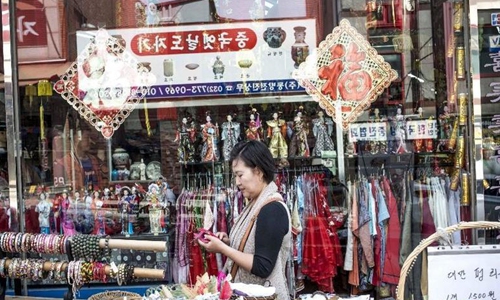HOME >> SOURCE
S.Korea's real GDP growth hits 10-year low in 2019
Source:Xinhua Published: 2020/1/22 15:08:01

Traditional Chinese and South Korean ornaments are sold in the Chinatown. (Photo:Xinhua)
South Korea's real gross domestic product (GDP), adjusted for inflation, posted the lowest growth in 10 years last year, central bank data showed Wednesday.
The real GDP grew 2.0 percent in 2019 from the previous year, after expanding 3.2 percent in 2017 and 2.7 percent in 2018 respectively, according to the Bank of Korea (BOK).
It was the lowest growth since 2009 when the real GDP edged up 0.8 percent on the negative effect from the global financial crisis.
The 2019 GDP expansion was below the estimated growth potential of 2.5-2.6 percent for the South Korean economy.
The economic slump was mainly attributed to the global trade dispute and the downturn of the global chip industry that led to an export fall for the 13th consecutive month through December.
The BOK estimated that the global trade spat pulled down last year's GDP growth by 0.4 percentage points.
According to the International Monetary Fund (IMF), the 2019 global economic growth was estimated at 2.9 percent, the lowest in 10 years since 2009.
South Korea's export climbed 1.5 percent last year, but it was lower than a 3.1 percent expansion estimated by the BOK in early 2019. The outbound shipment expanded 3.5 percent in 2018.
Hit by the export slowdown, facility investment tumbled 8.1 percent in 2019 after sliding 2.4 percent in 2018.
Investment in the construction sector retreated 3.3 percent in 2019 after skidding 4.3 percent in the prior year amid the government's efforts to curb speculative investment in the real estate market.
Fiscal spending went up 6.5 percent last year on the government's measures to prop up the sagging economy, such as the supplementary budget. The fiscal expenditure grew 5.6 percent in 2018.
Private consumption, another engine of growth for the export-driven economy, rose 1.9 percent last year, but it was lower than a 2.8 percent increase in 2018.
The private sector raised the real GDP growth by 0.5 percentage points last year, while the public sector lifted it up by 1.5 percentage points.
Meanwhile, the real GDP contracted 0.4 percent in the January-March quarter from three months earlier, marking the lowest in 41 quarters since the fourth quarter of 2008.
The GDP growth rebounded to 1.0 percent in the second quarter, but it slowed to 0.4 percent in the third quarter.
From three months earlier, the real GDP advanced 1.2 percent in the October-December quarter on the government's efforts to bolster the lackluster economy.
The fourth-quarter GDP growth was the highest in nine quarters since the third quarter of 2017. It was due to the improved private consumption, facility investment and construction investment that offset the export slump.
During the fourth-quarter, private consumption gained 0.7 percent compared with the previous quarter, after adding 0.2 percent in the third quarter.
Construction investment jumped 6.3 percent in the fourth quarter from three months earlier, after diving 6.0 percent in the third quarter.
Facility investment increased 1.5 percent in the fourth quarter, higher than a 0.6 percent growth in the prior quarter.
Export inched down 0.1 percent in the October-December quarter from the previous quarter, after rising 4.6 percent in the July-September quarter.
Fiscal spending picked up 2.6 percent in the fourth quarter on a quarterly basis, after increasing 1.4 percent in the third quarter.
RELATED ARTICLES:
Posted in: ECONOMY,BIZ FOCUS